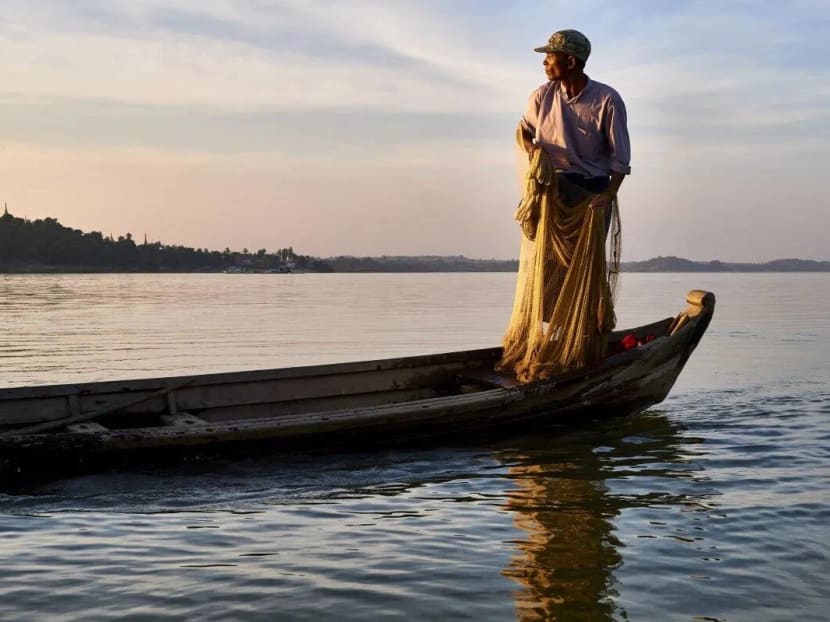Fishermen’s friends: Dolphins under threat in Myanmar, but eco-tour group works to save them
Dolphin whisperer U Aung Thinn taps a hand-carved stick on the side of his slender boat and patiently waits. As he spots the dolphins’ grey arches gracefully moving towards him, he gathers his fishing equipment.

Dolphins and fishermen work together in Myanmar’s Irrawaddy River, where the marine mammals are under threat from overfishing. Mr U Aung Thinn (above) has been practising this form of cooperative fishing since the age of 12.
MYANMAR — Dolphin whisperer U Aung Thinn taps a hand-carved stick on the side of his slender boat and patiently waits. As he spots the dolphins’ grey arches gracefully moving towards him, he gathers his fishing equipment.
One of the dolphins flicks its tail out of the water, sending the signal for Mr Thinn to cast his net. The mammals corral fish towards the boat. As the fish swarm into the net, the dolphins devour the inevitable overspill.
However, like the dolphins, the future of Myanmar’s cooperative fishing is under threat.
“The big difference is the fish population,” says 51-year-old Thinn. When he started fishing at the age of 12, his hauls were much heavier. “It’s difficult to compete with electrofishing now, and some people have to work in other jobs to make a living.”
Mr Thinn is one of about 60 remaining cooperative fishermen who work alongside the small pocket of Irrawaddy dolphins along this stretch of the Irrawaddy River close to Mandalay. The latest WWF count in February recorded 76 dolphins in Myanmar, where they are classified as critically endangered by the IUCN. Worldwide, they are also classified as endangered, with only about 3,000 of the species estimated to remain.
Thinn’s father taught him how fishermen and dolphins can work together. Featuring in folktales that date back centuries, the method has seen generations of Burmese build a mutually beneficial relationship with the majestic water mammals.
Pollution, climate change and illegal fishing have depleted fish stocks, and cooperative fishing – once revered for landing hauls up to six times larger than other methods – has been replaced with modern techniques.
“It’s difficult to learn, and the younger generation do not want to do it now; fishing is becoming harder and it’s not economically viable,” says Mr Paul Eshoo, project adviser for Living Irrawaddy Dolphin Project. “Cheaper nets and fishing equipment make that form of fishing more efficient.”
In a bid to save the Irrawaddy dolphins while providing additional income for cooperative fishing communities, last year Mr Eshoo joined forces with local tour company Living Irrawaddy Travel to launch Living Irrawaddy Dolphin Project.
The social business runs one- to three-day trips from Mandalay into the heart of rural Myanmar. All profits are ploughed back into the seven cooperative fishing communities the company works with, and towards protecting the dolphins.
One conservation project sees Living Irrawaddy Dolphin Project rent part of the Irrawaddy River, where it enforces strict regulations and hires villagers to patrol the waters for illegal fishing.
“The whole river was being developed for fishing contracts where people can bid to rent parts of it,” says Eshoo. “This incentivises overfishing and the use of illegal fishing methods, so we invested in a main area where the dolphins are, to protect it.”
Cruising along the Irrawaddy River, guests travel on a boat that docks at villages that are home to artisan hat makers and basket weavers. Excursions include meeting monks at ancient monasteries, strolling through sacred forests and making pottery by hand. Accommodation is in the form of glamping in bell tents set up on islands.
But the highlight is accompanying a cooperative fisherman in his boat and seeing how he communicates with dolphins.
Fishermen have names for each of the mammals, some of whom they have known for decades.
“The dolphins are really clever, and playful,” says Mr Eshoo. “Fishermen tell me when they are trying to take a nap, dolphins will nudge the boat and wake them with a squirt of water from their blowhole.”
“The relationship with dolphins is not as good as it was in the old days,” laments Mr Thinn.
Electrofishing has taken its toll and has surged in recent years, thanks to the introduction of cheap batteries from China. This illegal practice sees fishermen plunge batteries into the water, stunning fish so they can easily be collected. It is rapidly depleting fish stocks.
It has also been blamed for the death of several of the animals. The electric fishermen sometimes try to mimic the cooperative fishermen to get the dolphins to move fish towards the boat, and in some cases the dolphins get electrocuted, says Mr Eshoo. “But the bigger issue is that electric fishing destroys the fish population, making it difficult for dolphins to find food,” he says.
“Dolphins have become wary of boats and fishermen and this is sad to see after so long,” says Mr Eshoo. “We hope this initiative will help strengthen the bond between the fishermen and dolphins.” SOUTH CHINA MORNING POST






